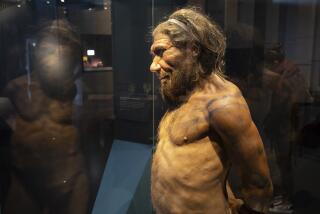Anthropologist Looks to the Child for Clues to Our Evolutionary Past : THE DESCENT OF THE CHILD <i> by Elaine Morgan</i> ; Oxford University Press $19.95, 197 pages
Newborn babies can’t shiver or cry tears, and their windpipes haven’t descended far enough to facilitate speech (which may account for SIDS--sudden infant death syndrome). But contrary to popular lore, they can smile (it’s not gas), and they do.
These facts and more fill the pages of “The Descent of the Child,” British anthropologist Elaine Morgan’s latest effort to sell her theory that humans evolved into brainy beings because, unlike the ape, our hominid ancestors spent hundreds of thousands of years in the sea that once occupied much of central Africa. She calls this the Aquatic Ape theory.
The gist of this slim book is that most of the traits that distinguish us from all other animals develop in the last four months of gestation and in the newborn infant. These traits, which have evolved to meet the unique demands of our oversized brains and underdeveloped bodies, enable human infants to exploit their environment.
She admonishes other evolutionists to look to the child for clues to our evolutionary past. Of course, Morgan is not the first to notice these peculiarly human behaviors, but she does offer a coherent explanation that leads, inevitably, to that ancient African sea.
En route, she provides a rollicking review of human sexuality (with her own take on such controversial issues as female orgasm and the practice of clitoridectomy), childbirth in warm water and mother-infant competition. Even readers who may not accept her primary argument will take away from this pithy treatise enough nuggets to nourish conversation for at least the nine months it takes to produce a human baby.
That baby, she reveals, begins developing like the fetuses of other primates and remains monkey-like for its first four months in utero (retaining its tail far longer than fetal apes). At five months, however, things begin to change, and the human fetus develops differently from all other mammals. While human children are uncannily like infant chimps, gorillas and orangutans, as I learned when administering Piaget tests to the latter, there are obvious differences in matters of body fur, speech and brain size. Morgan focuses on these differences to explain the special path of human evolution.
New data, she suggests, explode the theory that early hominids were forced into the savanna, where they developed large brains in order to develop the bipedalism necessary to hunt on two legs and fight with hand weapons.
That we did not linger in the savanna, she says, is obvious from our lack of body hair, subcutaneous fat that bonds to our skin and a waterproof coating called vernix caseosa that covers most babies before they are born so that they arrive in the world smeared like long-distance swimmers.
Morgan argues that the only good explanation for these anomalies-- comes from our adaptation to life underwater. None of these features are found in savanna animals, she points out, but examples of all of them can be found in aquatic or semi-aquatic creatures.
“The Descent of the Child” traces the development of these traits through nine months of gestation and the succeeding 12 months. The extra year is the time that a human infant would continue in utero if a human were born as mature as other primates, able in large part to fend for itself.
As it is, mothers need to expel babies prematurely so that their skulls can continue to grow. These infants need constant attention and have evolved tricks to get it, such as crying until someone comes to their aid and smiling to initiate cuddling. Human babies alone can maintain eye contact when they are breast feeding and have a face full of expressions to keep care givers attentive.
Yet unlike geese and piglets, human infants do not form instant bonds with a single individual. They only form personal attachments after six months, and even then, Morgan explains, babies respond to the care giver who arrives the quickest, not necessarily someone with familial ties.
“The Descent of the Child” is fun. It leaves the reader rich in anecdote, semi-convinced about Morgan’s controversial theory, and very informed about infant development. Divided into short, cookie-sized chapters, it fills the bill for a pick-me-up during the inevitable wakeful hours that are part of caring for these incredibly canny, diminutive creatures.




